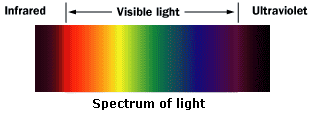

Thermal Imaging Explained
GENERAL OVERVIEW:

Light Basics: In order to understand thermal imaging, it is important to understand something about light.
The amount of energy in a light wave is related to its wavelength: Shorter wavelengths have higher energy.
Of visible light, violet has the most energy, and red has the least. Just next to the visible light spectrum is
the infrared spectrum.
The amount of energy in a light wave is related to its wavelength: Shorter wavelengths have higher energy.
Of visible light, violet has the most energy, and red has the least. Just next to the visible light spectrum is
the infrared spectrum.
Infrared light can be split into three categories:

The key difference between thermal-IR and the other two is that thermal-IR is emitted by an object instead
of reflected off it. Infrared light is emitted by an object because of what is happening at the atomic level.
of reflected off it. Infrared light is emitted by an object because of what is happening at the atomic level.
Thermal Imaging - Here's how it works:
A special lens focuses the infrared light emitted by all of the objects in view.
The focused light is scanned by a phased array of infrared-detector elements. The detector elements
create a very detailed temperature pattern called a thermogram. It only takes about one-thirtieth of a
second for the detector array to obtain the temperature information to make the thermogram. This
information is obtained from several thousand points in the field of view of the detector array.
The focused light is scanned by a phased array of infrared-
create a very detailed temperature pattern called a thermogram. It only takes about one-
second for the detector array to obtain the temperature information to make the thermogram. This
information is obtained from several thousand points in the field of view of the detector array.
The thermogram created by the detector elements is translated into electric impulses.
The impulses are sent to a signal-processing unit, a circuit board with a dedicated chip that translates
the information from the elements into data for the display. The signal-processing unit sends the
information to the display, where it appears as various colors depending on the intensity of the infrared
emission. The combination of all the impulses from all of the elements creates the image.
The impulses are sent to a signal-
the information from the elements into data for the display. The signal-
information to the display, where it appears as various colors depending on the intensity of the infrared
emission. The combination of all the impulses from all of the elements creates the image.
Types of Thermal Imaging Devices
Most thermal-
ranging from -
changes in temperature of about 0.4 F (0.2 C). See: Thermal-
There are two common types of thermal-
Un-
contained in a unit that operates at room temperature. This type of system is completely quiet, activates
immediately and has the battery built right in.
Cryogenically cooled -
have the elements sealed inside a container that cools them to below 32 F (zero C). The advantage of
such a system is the incredible resolution and sensitivity that result from cooling the elements.
Cryogenically-
(300 m) away, which is enough to tell if a person is holding a gun at that distance!
Unlike traditional most night-
thermal imaging is great for detecting people or working in near-
no ambient lighting (i.e. stars, moonlight, etc, ) Thermal Imaging Explanation -